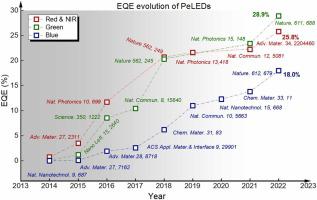Journal of Alloys and Compounds ( IF 5.8 ) Pub Date : 2023-06-02 , DOI: 10.1016/j.jallcom.2023.170823 Xinyue Cui , Ya Li , Zhewei Chen , Yatao Zou , Yuqiang Liu , Baoquan Sun , Zhishan Bo

|
The charge transport layer is a critical functional component in perovskite light emitting-didoes (PeLEDs). Metal oxide semiconductors (MOSs) are attractive charge transport materials owing to their advantages of robust stability, high carrier mobility, high transparency, as well as low cost. However, because of the complex mutual chemistry disturbance between the metal oxide and luminescent halide perovskite, there are severe charge quenching and even decomposition of the perovskite layers. Therefore, the advance of MOSs as charge transport layers in PeLEDs is still confined within selective cases. It is a prerequisite to gain depth insight into the interfacial contact between perovskites and MOSs from surface chemistry reactions and charge quenching before the realization of MOSs charge transport layers for constructing efficient and stable PeLEDs. In this review, we started with a brief introduction to perovskite materials and the development of PeLEDs. Then, we highlighted the importance of the interfacial contacts between perovskite and charge transport layers, followed by summarizing the progress of PeLEDs using MOSs as charge transport layers from the aspects of surface reaction, crystallization, quenching mechanism, charge injection, and operational stability. We also proposed possible research directions on engineering MOSs charge transport layers that would further improve the performance of PeLEDs.
中文翻译:

以高效稳定的钙钛矿发光二极管为目标的金属氧化物电荷传输层
电荷传输层是钙钛矿发光二极管 (PeLED) 中的关键功能组件。金属氧化物半导体 (MOS) 具有稳健稳定性、高载流子迁移率、高透明度以及低成本等优点,因此是极具吸引力的电荷传输材料。然而,由于金属氧化物和发光卤化物钙钛矿之间复杂的相互化学干扰,钙钛矿层存在严重的电荷猝灭甚至分解。因此,将 MOS 作为 PeLED 中的电荷传输层的进展仍然局限于选择性案例。在实现 MOS 电荷传输层以构建高效稳定的 PeLED 之前,从表面化学反应和电荷猝灭深入了解钙钛矿和 MOS 之间的界面接触是先决条件。在这篇综述中,我们首先简要介绍了钙钛矿材料和 PeLED 的发展。然后,我们强调了钙钛矿和电荷传输层之间界面接触的重要性,然后从表面反应、结晶、猝灭机制、电荷注入和操作稳定性等方面总结了使用 MOS 作为电荷传输层的 PeLED 的进展。我们还提出了工程 MOS 电荷传输层的可能研究方向,这将进一步提高 PeLED 的性能。我们首先简要介绍了钙钛矿材料和 PeLED 的发展。然后,我们强调了钙钛矿和电荷传输层之间界面接触的重要性,然后从表面反应、结晶、猝灭机制、电荷注入和操作稳定性等方面总结了使用 MOS 作为电荷传输层的 PeLED 的进展。我们还提出了工程 MOS 电荷传输层的可能研究方向,这将进一步提高 PeLED 的性能。我们首先简要介绍了钙钛矿材料和 PeLED 的发展。然后,我们强调了钙钛矿和电荷传输层之间界面接触的重要性,然后从表面反应、结晶、猝灭机制、电荷注入和操作稳定性等方面总结了使用 MOS 作为电荷传输层的 PeLED 的进展。我们还提出了工程 MOS 电荷传输层的可能研究方向,这将进一步提高 PeLED 的性能。随后从表面反应、结晶、猝灭机制、电荷注入和操作稳定性等方面总结了使用MOS作为电荷传输层的PeLED的进展。我们还提出了工程 MOS 电荷传输层的可能研究方向,这将进一步提高 PeLED 的性能。随后从表面反应、结晶、猝灭机制、电荷注入和操作稳定性等方面总结了使用MOS作为电荷传输层的PeLED的进展。我们还提出了工程 MOS 电荷传输层的可能研究方向,这将进一步提高 PeLED 的性能。











































 京公网安备 11010802027423号
京公网安备 11010802027423号